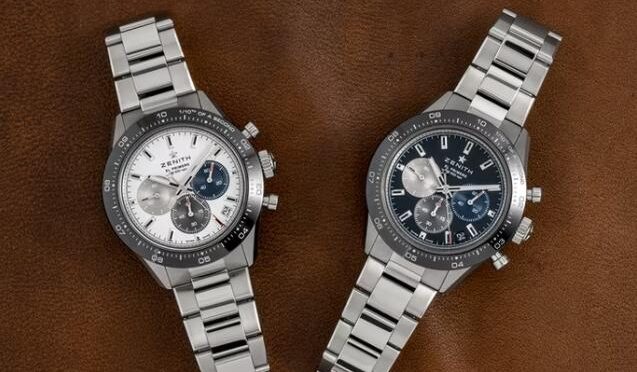
The El Primero caliber 400 is an anachronism, but a wonderful one. The first high-frequency automatic chronograph movement, it was introduced (along with the Seiko 6309 and the Breitling/Heuer/Buren caliber 01) in 1969 and it has, rather astonishingly, persisted down to the present day. The movement’s design, however, is also a relic of its time – for instance, there are a number of different size screws, more than you’d see in a movement designed today, which makes manufacturing comparatively time, labor, and cost-intensive. The Zenith Chronomaster Sport, launched today by Zenith, uses a new movement: the caliber 3600, which is designed to reduce parts count, take advantage of modern materials and manufacturing processes, and offer improved functionality.
The watch also bears, at first glance, a startling resemblance to the Rolex Daytona – exactly how close the resemblance is, and whether the proximity is problematic, we’ll explain shortly.
The new Zenith Chronomaster Sport draws from a well-established design vocabulary. The overlapping sub-dials and color scheme go all the way back to the 1969 El Primero A386 and Zenith says that the general configuration of the case was inspired by the so-called “De Luca” models. These were produced starting in the late 1980s and were the first watches from Zenith to use the El Primero 400 caliber after the movement was resurrected – albeit in a highly modified configuration – by Rolex, for the Daytona ref. 16520 (this was the caliber 4030, the first automatic chronograph movement to be used in the Daytona).
The De Luca broke no new ground in chronograph design, with its round case and pump-style pushers, but it’s a watch I’m surprised has not generated more interest among collectors, as it came into existence at a significant moment in Zenith’s history and the history of the El Primero movement – an attractive design if not a revolutionary one. Today, the Chronomaster case is a well-established part of the existing Zenith catalog, and the new Chronomaster Sport likewise establishes no new paradigms in chronograph design, but it’s a handsome modern example of a vintage-adjacent watch, which goes a long way nowadays.
At 41mm and on its steel bracelet, it seems a solid addition to Zenith’s lineup and an attractive, if not instantly compelling, addition to the company’s El Primero chronograph offerings. However, a close look at the bezel tips you off that there is more going on under the hood than first meets the eye.
The Chronomaster Sport’s bezel is marked off in 1/10 of a second increments, and the center chronograph hand goes around once every ten seconds. Each of the smaller tick marks represents one one-tenths of a second.
The El Primero 3600 is a new movement for Zenith and the newest version of the original El Primero caliber – Zenith’s used it in a handful of limited editions (including a 50th Anniversary LE), but the new Chronomaster Sport is the first regular production Zenith to use it. While at first glance it looks nearly identical to the El Primero 400, there have been some major technical upgrades.
In the diagram above, the chronograph driving mechanism for the El Primero 400 is on the left, and the one for the 3600 on the right. The 400 is a traditional setup – the movement’s 4th wheel (the lower yellow gear) drives the driving wheel and coupling wheel (the upper two yellow gears). When the chronograph is activated, the coupling wheel drops into contact with the central chronograph wheel and the chronograph begins running, with the center chronograph hand going around the dial once per minute. In the caliber 400, the hand advances every tenth of a second. If you’re into chronographs you’ll recognize this as a classic, lateral clutch, column-wheel-controlled chronograph mechanism.
The caliber 3600 set up looks superficially the same, but if you look closely, you’ll see that the chronograph driving and coupling wheels aren’t driven by the fourth wheel. Instead, they’re driven by a pinion on the escape wheel (the wheel with the star-shaped spokes on the left). Driving the chronograph off the escape wheel is what allows the caliber 3600 to measure 1/10th of a second increments – as far as I know, this is one of a very few 1/10th second chronograph to use a single oscillating system for both the chronograph and the primary going train.
The reason you don’t usually see chronographs driven by the escape wheel is that, generally, it’s a terrible idea to try. Driving a chronograph from the fourth wheel is already kind of pushing it; it’s the last conventional wheel in the going train, and stealing energy from the gears at that point means less energy is available to reach the balance. Balance amplitude can drop significantly when a chronograph is switched on, and if the watch isn’t in optimum condition, accuracy can suffer if you leave the chronograph on for long enough. The problem is even worse if you try to drive the chronograph off the escape wheel. The amount of energy available is even less than at the fourth wheel, and adding the load of driving the chronograph is potentially even more problematic. Zenith Chronomaster Sport has gotten around this problem partly by using low-inertia silicon for the escape wheel, but a lot of the mitigation comes from customization of the driving and coupling wheels, each of which has a unique profile for the gear teeth.